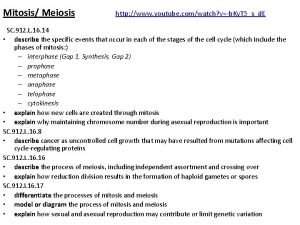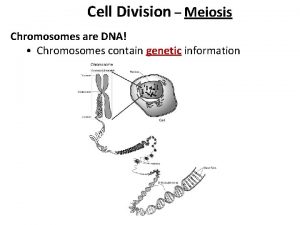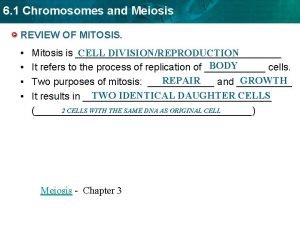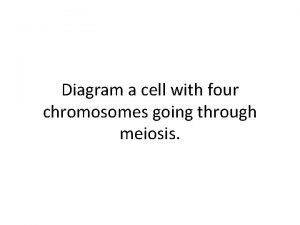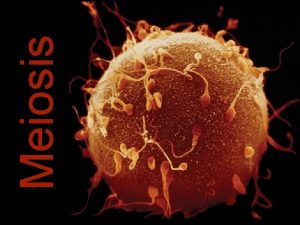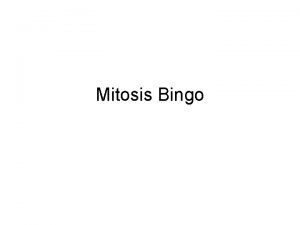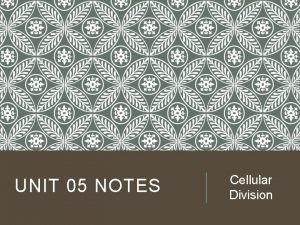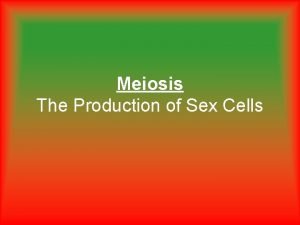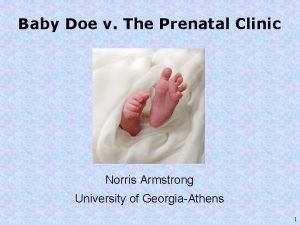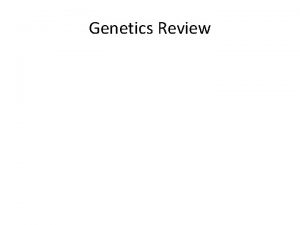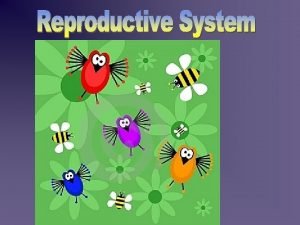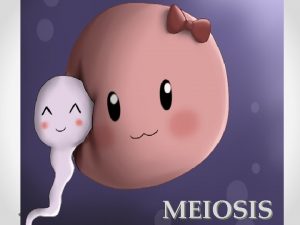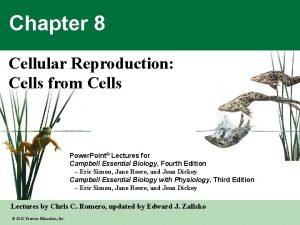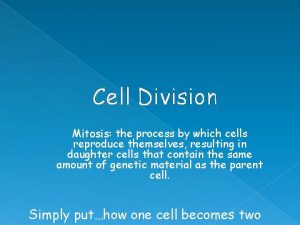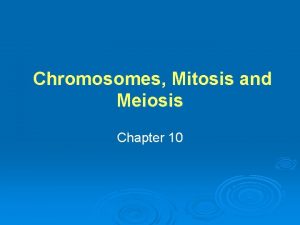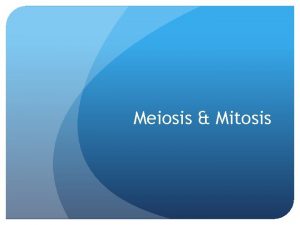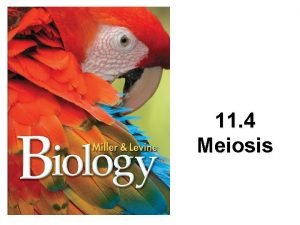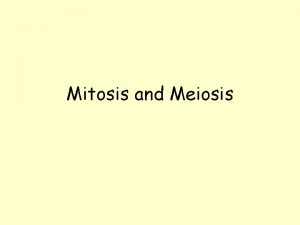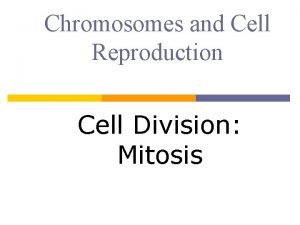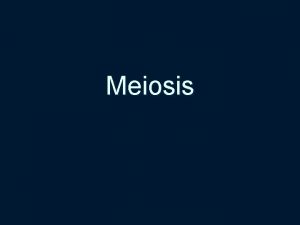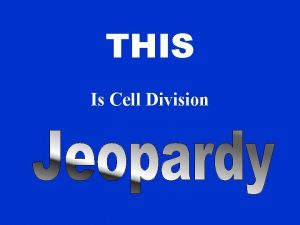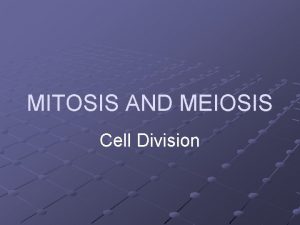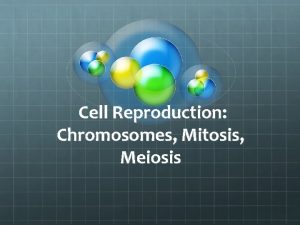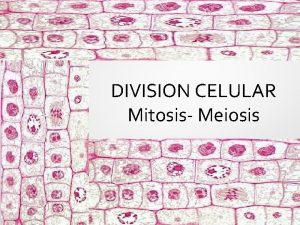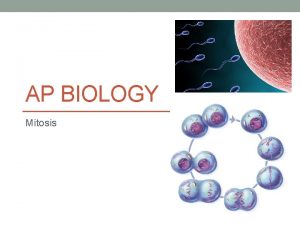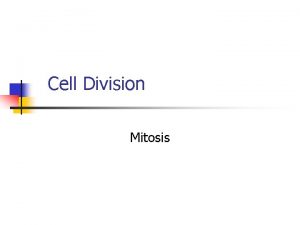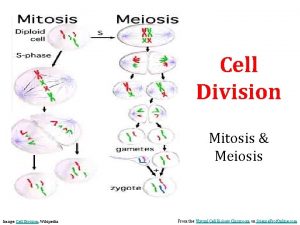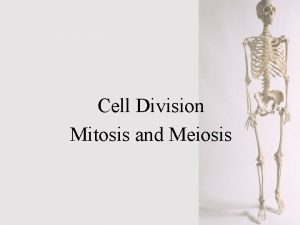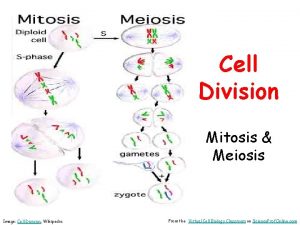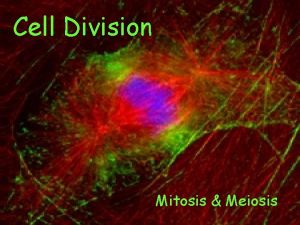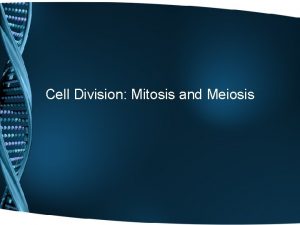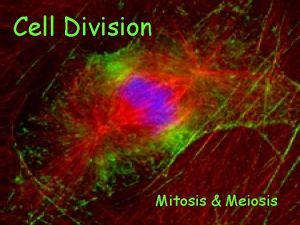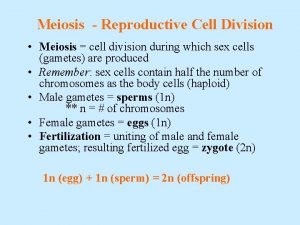Cell Division Mitosis Meiosis Chromosomes in us Humans





















- Slides: 21

Cell Division: Mitosis & Meiosis

Chromosomes in us • Humans have diploid cells – Diploid (2 n) = two sets of each chromosome (2 n = 46, where n is 23) – Haploid (n) = one set of each chromosome • Arranged in pairs known as homologous chromosomes = chromosomes pairs that are of the same length and staining pattern and possess genes for the same characters at the same length

Terms – refresher • Chromatid = one of two copies of DNA • Sister chromatids = two identical copies of DNA • Centromere = region on chromosome that joins sister chromatids • Spindle fiber = microtubules that move chromosomes during cell division • Centriole = microtubule organizing center

Stages of the cell cycle • interphase – G 1: growth, protein synthesis, increase in the number of mitochondria and/or chloroplasts – S: DNA replication – G 2: growth, protein synthesis, preparation for mitosis/cytokinesis • mitosis = nuclear division – – prophase metaphase anaphase telophase • cytokinesis = cellular division

Prophase • Chromosomes condense by supercoiling, becoming visible to microscopic view • Centrioles move to opposite poles • Nucleolus disappears • Nuclear membrane disappears • Microtubular spindle apparatus forms at each pole

Metaphase • Spindle microtubules attach to chromosome centromeres • Chromosomes move to the equator

Anaphase • Centromeres split as spindle microtubules pull chromatids to opposite poles (after centromeres split, sister chromatids are known as sister chromosomes) • Sister chromosomes move to opposite poles as microtubules shorten

Telophase • Sister chromosomes have arrived at poles • Spindle disappears • Centrioles replicate • Nuclear membrane reforms and becomes visible • Nucleolus becomes visible • Chromosomes decondense, becoming chromatin

Cell Division: Mitosis & Meiosis

Signs of down syndrome • Multiple developmental and health effects including: • Short stature, distinct facial features. • Mild to moderate physical and cognitive impairment. • Increased risk of problems involving heart, respiratory, digestive, hearing, vision, and/or thyroid glands. • Trisomy 21 (95% of all cases): three complete copies in all cells. • Mosaicism (1 -2% of cases): three copies in some but not all cells.

Karyotype • Organization of chromosomes of a cell according to size and structure • Each human cell has 23 pairs of chromosomes (22 pairs of autosomes, 1 pair of sex chromosome) • Can detect gene mutations = change in base sequence of a gene

Which is male and which is a female karyotype?

What is different about this karyotype? 13

Down syndrome • A chromosomal disorder resulting from a partial or complete extra copy of chromosome 21. 14

The paradox Human beings have 46 chromosomes in each cell. Your mom has 46 chromosomes in each cell. Your dad has 46 chromosomes in each cell. But you do not have 92 chromosomes in your cell. WHY?

4. 2. 3 Meiosis: Reduction division from diploid to haploid cells 1. Paring of homologous chromosomes 2. Two divisions – Meiosis I: homologous chromosomes split – Meiosis II: sister chromatids split 3. Product: Four haploid (n) cells

Meiosis VS Mitosis

Meiosis • I Prophase I: – chromosomes condense – spindle forms – pairing of homologous chromosomes • Metaphase I: – • homologous chromosomes line up at equator Anaphase I: – Spindle attach to chromosomes and pull homologous chromosomes to separate poles • Telophase I: – Chromosomes arrive at opposite poles of cell – Spindle disappears Q. Is the cell a diploid/haploid at this stage?

Meiosis • IIProphase II: – chromosomes condense – spindle forms • Metaphase I: – individual chromosomes line up at equator • Anaphase I: – Spindle attach to chromatids and pull sister chromatids to separate poles • Telophase I: – Chromatids arrive at opposite poles of cell – Spindle disappears

Mitosis versus Meiosis

Down syndrome • Chromosomes move to pole as a pair instead of singly • Thus, egg or sperm contain an extra copy of chromosome 21, and fertilized egg has 3 copies of chromosome 21 • Occurs in meisos I or II
 Mitosis and meiosis
Mitosis and meiosis Two cells are produced
Two cells are produced Chromosomes number is maintained mitosis or meiosis
Chromosomes number is maintained mitosis or meiosis Meiosis 1 and 2
Meiosis 1 and 2 Number of chromosomes in meiosis and mitosis
Number of chromosomes in meiosis and mitosis Chromosomes number is maintained mitosis or meiosis
Chromosomes number is maintained mitosis or meiosis Meiosis diagram
Meiosis diagram Mitosis and meiosis diagram
Mitosis and meiosis diagram Concept comparing mitosis and meiosis
Concept comparing mitosis and meiosis Mitosis cell division
Mitosis cell division Karyotype
Karyotype How many chromosomes does a human have
How many chromosomes does a human have How many chromosomes do humans have
How many chromosomes do humans have What did gregor mendel do
What did gregor mendel do Where in the female reproductive system does meiosis occur
Where in the female reproductive system does meiosis occur Homologous chromosome definition
Homologous chromosome definition Non disjunction in meiosis 1 and 2
Non disjunction in meiosis 1 and 2 Number of divisions in mitosis
Number of divisions in mitosis Non kinetochore microtubules
Non kinetochore microtubules Meiosis
Meiosis Number of chromosomes in meiosis
Number of chromosomes in meiosis Events of the cell cycle
Events of the cell cycle


